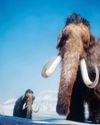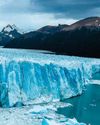REDISCOVERING THE DINOSAURS
How It Works UK
|Issue 203
They're often depicted as huge, scaly beasts, but new discoveries are changing our beliefs about the creatures that once stalked our planet

VELOCIRAPTOR
One of Jurassic Park's stars was more chicken-like than reptilian
Most people associate the Cretaceous Velociraptor with its appearance in the blockbuster Jurassic Park. In the film, the Velociraptor is a human-sized, scaly predator that's able to open doors with its flexible, down-turned hands, looking somewhat like a bipedal Komodo dragon. In reality, Velociraptor probably didn't look much like this at all. Recent research shows Velociraptor was considerably smaller, less than a metre tall and under 20 kilograms in weight, with its hands fixed into a palms-inward posture just like that present in birds today.
The key difference in its appearance, however, was the presence of plumage. Thanks to numerous beautifully preserved fossils discovered in the Jurassic and Cretaceous rocks of eastern China, we now know beyond doubt that many dinosaurs, including the Velociraptor, were feathered. And they didn't just possess a few sparse tufts or filaments here and there - they were covered in a thick, extensive coat, just like modern birds.
Long feathers covered their arms and hands, obscuring the clawed fingers from view, and the feathering also extended down the legs to the ankles. The face and much of the snout and jaws were festooned in fuzz, while the entire neck, body and tail were thickly covered. In fact, Velociraptor and related dinosaurs must have looked like ground-striding, short-winged hawks rather than the scaly lizard-monsters made famous by Steven Spielberg.
 ORNITHOMIMUS
ORNITHOMIMUSSuperbly preserved specimens suggest these dinosaurs resembled ostriches
Diese Geschichte stammt aus der Issue 203-Ausgabe von How It Works UK.
Abonnieren Sie Magzter GOLD, um auf Tausende kuratierter Premium-Geschichten und über 9.000 Zeitschriften und Zeitungen zuzugreifen.
Sie sind bereits Abonnent? Anmelden
WEITERE GESCHICHTEN VON How It Works UK
How It Works UK
20 WEARABLE HEALTH TRACKERS
Whether you strap a wellness coach to your wrist or weave subtle sensors into your clothes, these devices are revolutionising how we track our health
9 mins
Issue 210
How It Works UK
SUPERPOWERED PLANTS
The world of plants is vibrant and diverse, just like this book.
1 min
Issue 210
How It Works UK
SECRET STORIES OF LOST BEASTS
We're all aware of the mighty dinosaurs that once roamed Earth, but there are so many weird and wonderful species that have been lost to time.
1 min
Issue 210

How It Works UK
ALL ABOUT BLIMPS
Is it a bird? Is it a spaceship? No... it's a non-rigid airship
2 mins
Issue 210
How It Works UK
SUPER QUESTERS MISSION: RAINFOREST MAGIC
Join adventurers Leo, Lilli and Bea as they transform into superheroes and journey to the rainforest in the pursuit of knowledge.
1 min
Issue 210

How It Works UK
HOW THE MIGHTY MAMMOTH RULED THE ICE AGE
Meet the prehistoric giants that roamed the Arctic Circle thousands of years ago
4 mins
Issue 210
How It Works UK
Have they found LIFE ON MARS?
Although it's by no means certain, scientists are slowly accumulating evidence that life once existed on the Red Planet
2 mins
Issue 210

How It Works UK
HOW FAST DO GLACIERS MOVE?
The speed at which a glacier flows depends on its mass, the depth and slope of the underlying rock bed and friction.
1 min
Issue 210

How It Works UK
HOW IN-FLIGHT WI-FI WORKS
This technology allows you to scroll to your heart's content while killing time at cruise altitude
3 mins
Issue 210

How It Works UK
HOW WIGWAMS WERE BUILT
Discover the construction and living conditions inside these traditional domed dwellings
1 mins
Issue 210
Listen
Translate
Change font size

